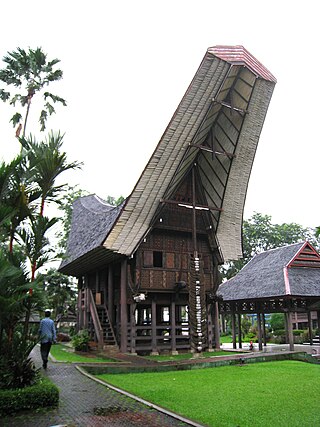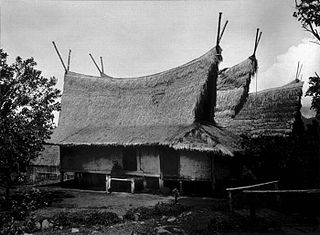
Aceh, officially the Province of Aceh, is the westernmost province of Indonesia. It is located on the northern end of Sumatra island, with Banda Aceh being its capital and largest city. It is bordered by the Indian Ocean to the west, Strait of Malacca to the northeast, as well bordering the province of North Sumatra to the east, and shares maritime borders with Malaysia and Thailand to the east, and Andaman and Nicobar Islands of India to the north. Granted a special autonomous status, Aceh is a religiously conservative territory and the only Indonesian province practicing Sharia law officially. There are ten indigenous ethnic groups in this region, the largest being the Acehnese people, accounting for approximately 70% of the region's population of about 5.5 million people in mid-2023. Its area is comparable to Croatia or Togo.

The Aceh War, also known as the Dutch War or the Infidel War (1873–1904), was an armed military conflict between the Sultanate of Aceh and the Kingdom of the Netherlands which was triggered by discussions between representatives of Aceh and the United States in Singapore during early 1873. The war was part of a series of conflicts in the late 19th century that consolidated Dutch rule over modern-day Indonesia.

Great Aceh Regency is a regency of the Indonesian province of Aceh. The regency covers an area of 2,903.49 square kilometres and had a population of 351,418 at the 2010 Census, 391,870 at the 2015 census and 405,535 at the 2020 Census; the official estimate as at mid 2023 was 435,298. The Regency is located at the northwest tip of Sumatra island and surrounds the provincial capital of Banda Aceh, many suburbs of which lie within the Regency. It also includes a number of islands off the northern tip of Sumatra, which comprise Pulo Aceh District within the regency. The seat of the Regency government is the town of Jantho.

Rumah Gadang or Rumah Bagonjong "house for the Minangkabau people" are the traditional homes of the Minangkabau in West Sumatra, Indonesia. The architecture, construction, internal and external decoration, and the functions of the house reflect the culture and values of the Minangkabau. A Rumah Gadang serves as a residence, a hall for family meetings, and for ceremonial activities. In the matrilineal Minangkabau society, the Rumah Gadang is owned by the women of the family who live there; ownership is passed from mother to daughter.

The architecture of Indonesia reflects the diversity of cultural, historical, and geographic influences that have shaped Indonesia as a whole. Invaders, colonizers, missionaries, merchants, and traders brought cultural changes that had a profound effect on building styles and techniques.

Tongkonan is the traditional ancestral house, or rumah adat of the Torajan people, in South Sulawesi, Indonesia. Tongkonan has a distinguishing boat-shaped and oversized saddleback roof. Like most of the Indonesia's Austronesian-based traditional architectures, tongkonan are built on piles. The construction of tongkonan is a laborious work and it is usually built with the help of all family members or friends. In the original Toraja society, only nobles had the right to build tongkonan. Commoners live in smaller and less decorated homes called banua.

Baiturrahman Grand Mosque is a mosque located in Banda Aceh, Aceh, Indonesia. The Baiturrahman Grand Mosque is a symbol of religion, culture, spirit, strength, struggle and nationalism of the Acehnese people. The mosque is a landmark of Banda Aceh and has survived the 2004 Indian Ocean earthquake and tsunami.

The Acehnese are an indigenous ethnic group from Aceh, Indonesia on the northernmost tip of the island of Sumatra. The area has a history of political struggle against the Dutch colonial rule. The vast majority of the Acehnese people are Muslims. The Acehnese people are also referred to by other names such as Lam Muri, Lambri, Akhir, Achin, Asji, A-tse and Atse. Their language, Acehnese, belongs to the Aceh–Chamic group of Malayo-Polynesian of the Austronesian language family.

The Sakuddei or Sabiroet people are an ethnic group, one of at least eleven, on the island of Siberut, Indonesia. Siberut is the northernmost of the Mentawai Islands which are located 130 km (81 mi) to the west off the coast of Sumatra. The Sakuddei live in south-central Siberut in an egalitarian society, cut off from the outside world. They speak a dialect of the Malayo-Polynesian Mentawai language.

Batak architecture refers to the related architectural traditions and designs of the various Batak peoples of North Sumatra, Indonesia. Six groups of Batak speak separate but related languages: the Angkola, the Mandailing to the south, the Toba, to the north the Pakpak/Dairi, the Simalungun, and the Karo. While the groups are now Muslim or Christian, elements of the ancient Batak religion remain, particularly amongst the Karo.

Rumah adat are traditional houses built in any of the vernacular architecture styles of Indonesia, collectively belonging to the Austronesian architecture. The traditional houses and settlements of the several hundreds ethnic groups of Indonesia are extremely varied and all have their own specific history. It is the Indonesian variants of the whole Austronesian architecture found all over places where Austronesian people inhabited from the Pacific to Madagascar each having their own history, culture and style.

Aceh State Museum, popularly known as Aceh Museum or Banda Aceh Museum is a museum in Banda Aceh, Indonesia. It is one of the oldest museum in Indonesia.
The John and Katharine Tunkun Podjun Farm is a farm located at 9582 East 1 Mile Road in Ellsworth, Michigan. It was listed on the National Register of Historic Places in 2002.

The Colonial Exhibition, Dutch: Koloniale Tentoonstelling, took place in Semarang, Dutch East Indies in from 20 August through 22 November 1914. Colonial exhibitions were trade expositions. It was designed to "give a comprehensive picture of the Dutch Indies in their present prosperous condition." It was the first large scale exposition in the Dutch East Indies, and financed by the participating corporations with a subsidy from the Dutch East Indies government.

Rangkiang is a granary or rice barn that the Minangkabau people used to keep rice in. The rangkiang is a distinctive feature of Minangkabau architecture. The structure is traditionally found in the courtyard of a rumah gadang, the traditional house of Minangkabau people.

The Great Mosque of Palembang, also known as Sultan Mahmud Badaruddin I Great Mosque after the former Sultan of Palembang, is the main mosque of Palembang, the capital of South Sumatra. The mosque is the largest in South Sumatra, and the third largest mosque in Sumatra after the Grand Mosque of West Sumatra and Great Mosque of Pekanbaru.

A sopo is a treasury structure in the architecture of the Toba Batak people from North Sumatra, Indonesia. Its form is similar to that of a Batak traditional house with the exception of being smaller in size and a construction ritual that is the opposite of a Batak house. Sopo is used as a repository for various items, e.g. rice, magical items, or trophies. Sopo can also be used as a meeting point for social activities.

Rumah limas, also known as rumah bari, is a type of traditional house found in Palembang, South Sumatra, Indonesia. They can also be found in Baturaja. The house is traditionally made of wood and raised on stilts, with a stepped, or gradated, floor composed of two to five areas at slightly different heights, with a broad porch, and a distinctive roof. In Palembang, these houses are associated with the nobility and other people of high status.

Rumah ulu is a vernacular house found in the highland of South Sumatra, Indonesia. The house is associated with the Uluan people who reside in the region of the upstream of the Ogan and Musi River.

Sundanese traditional house refers to the traditional vernacular houses of the Sundanese people, who predominantly inhabited the western parts of Java island, Indonesia. The architecture of a Sundanese house is characterized by its functionality, simplicity, modesty, uniformity with a little detail, its use of natural thatched materials, and the quite faithful adherence to harmony with nature and the environment.
























